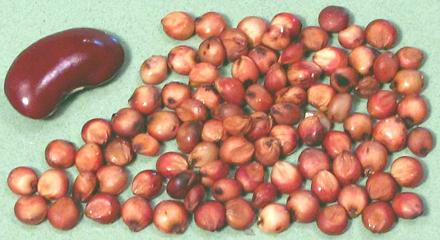 [Milo, Broom Straw, Egyptian Millet, Sudan Grass, Feterita, Shallu,
Kaffir Corn, Guinea Corn; Durra (Arabic); Jola, Jowari, Jawari, Juwar
(India); Gao-liang, Shushu (China); Sorghum bicolor]
[Milo, Broom Straw, Egyptian Millet, Sudan Grass, Feterita, Shallu,
Kaffir Corn, Guinea Corn; Durra (Arabic); Jola, Jowari, Jawari, Juwar
(India); Gao-liang, Shushu (China); Sorghum bicolor]
The first firm evidence of cultivated sorghum comes from India and Pakistan from before 1000 BCE - but it is not native there. It is now thought to have been first cultivated in Sudan, 4000 to 5000 BCE. Modern cultivars appear to have been developed in East Africa about 2000 years ago but exactly where has not been determined. It is still grown as a food crop over much of the world and is the 5th most cultivated grain worldwide.
The U.S. is the largest producer (mainly for animal feed and ethanol production). It was a $1 billion export market for US growers until the Trump Administration screwed everything up and China retaliated. It is also a major crop in India, Nigeria, Mexico and other countries with dry areas.
Sorghum is also the source of "broom corn", the straw from which brooms are made, and is used to make composition board for construction. The photo specimens, about 0.17 inch diameter, were taken from a bag of pigeon feed. The pigeons, for their part, would rather have less sorghum and more peas.
More on Other Grains.
In some regions sorghum replaces barley for production of beer, including by major name breweries in regions where barley doesn't grow well. It is also used for production of "gluten free" beer consumable by celiac sufferers. In China sorghum is used for production of distilled alcoholic drinks and vinegar.
In India, puffed sorghum is a popular snack. In China it is used with wheat in production of noodles and breads.
In the American South sorghum syrup made from a cultivar called "sweet sorghum" has long been used for pouring over pancakes as maple syrup is used in the north, though that usage is declining.